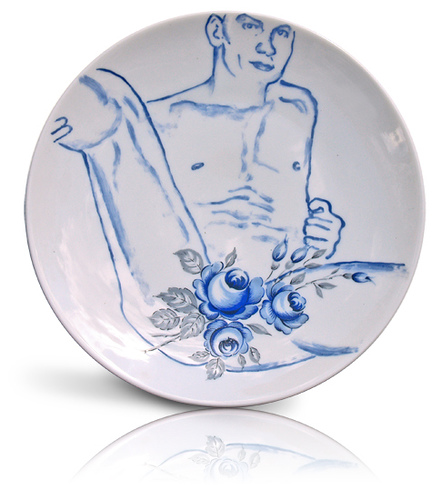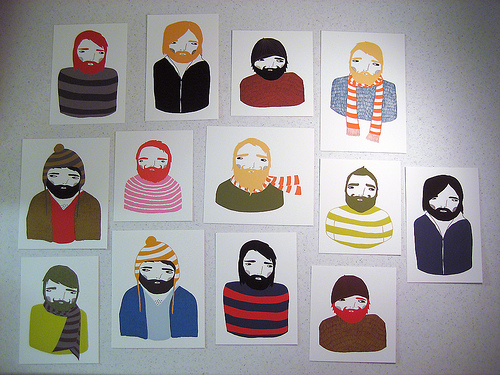Thinking about enhancing thrifted plates reminded me of the vintage vandals shows from 2005.
Month: January 2008
Blue Rose, campy modified plate set
About a thousand dollars for the set of six. More importantly, this gives me all kinds of ideas for things to do with thrift store plates.
Beards & stripes
Apparently these will be for sale on Etsy. I’m filing this under “knitting” because the stripes are giving me a yarn urge.
Ernst Haeckel, categorization, sets of sets, primary colours, dog tv
I fell into a bit of a well of naturalism and anatomy links, and ended up wanting to read Stuffed Animals and Pickled Heads: The Culture and Evolution of Natural History Museums, although I’m pretty sure it isn’t as critical or curious as I want it to be. One review quotes this tedious oversimplification as a “philosophical insight into the scientific and human impulse to categorize.”
“To have a concept… is to have its negation already in tow…. There is a class of things called ‘dog,’ and there is a class of things (quite substantial, in fact) that are ‘not-dog.’… Language and thought cannot really function without this most basic tool for carving up reality.”
Never heard of fuzzy continuums and the rewards of using them, I guess? Odd, since natural history museums are full of ambiguous specimens (two headed mutant dog, alleged dog-cow hybrid, newly discovered tentative dog, etc) that illustrate quite nicely the space between dog and not-dog. Sort of dog. Possible dog. Both dog and yet not dog. Natural history museums are pretty much ground zero for failed categorization schemes and fuzzy margins, sets that are more complicated than somebody was hoping they would be. Maybe the quote is just out of context. There are a lot of ellipses in there.
To balance out the sad saga of binary categories in science, I like to think about primary colours. These seem like a life-affirming, pro-ambiguity, scientific success. Primary colours are sets of colours that are chosen to maximize the usefulness of the spectrum between them. A noble, everybody-wins way to think about categorization, and also an easily visualized example of information organized into multiple overlapping continua. Wikipedia points out that “Any choice of primary colors is essentially arbitrary; for example, an early color photographic process, autochrome, typically used orange, green, and violet primaries.” Concrete! Maybe this is because colour science is so bluntly tied up in perception and perspective. It has to be aware of observer bias and intention, because it is about observing. My favourite bit of that Wikipedia page:
If a human and an animal both look at a natural color, they see it as natural; however, if both look at a color reproduced via primary colors, for example on a color television screen, the human may see it as matching the natural color, while the animal does not; in this sense, reproduction of color via primaries must be “tuned” to the color vision system of the observer.
I wonder how long it will be before someone makes a TV for dogs, with two kinds of pixels instead of RGB. Or TV for bees, with four kinds.
7 wrens, sets of sets
I was thinking about sets of sets when I came across this set of similar wrens, discussing the collections of identifying marks that make up a distinguishable bird species.
The same site has a lovely little discussion of preparing the mind to see birds.
Experts say that when we lose something, before we begin our search to find the lost thing we should picture the object in our minds. This kind of “visualization” causes the brain to do something wonderful. On the one hand, it appears to filter out many unnecessary sightings but, on the other, if something even remotely resembling the lost object comes into view, the mind seems to “jump” at it.
Power of pattern matching.
Sets of sets, letters with warping

Repetition with variation along two dimensions: different Rs, warped to different degrees.
Parrot fears, specialized info, flying
From a bird care listserv archive, info on birds’ fear of falling and about replacing missing feathers. There are so many cheesy human metaphors about flying that it is oddly moving to read about animals for whom flying has actual psychological importance.
Crap emails, man angst, better living through feminism…
I try to be calm and cool…… but my body language always gives me away & creeps women out some how. I start conversations easily, but I find myself saying too much or confusing women by saying things that they cannot understand or are too deep, for the amount of Vodka-Red Bulls that they have consumed.
This post at Letters From Johns reminds me of this (much longer and funnier) Crap Email From A Dude. They both remind me of crap emails I’ve received in the past from various acquaintances and from strangers who read about my vagina.
It’s weird to recognize a whole collection of traits— the insistence that they like women even though they are unable to avoid venting their anger at/about women, the over-analysis often constructed from one chapter of [dead guy of your choice], the obsession with yet lack of self-awareness (“I’m very direct, here’s 3000 words about nothing.”), the refusal of independent responsibility (“I hate it when people hang out with me even though they obviously think they’re too good for me.”), the fucked up gender stereotypes, the obsession with yet discomfort over sex… It’s a whole syndrome. In high school, my friends and I called these characters Deep Teen Smurf, or Bad Teenaged Poet.
Off and on, I’ve wished for a book to recommend to these guys, to help them snap out of it and get past being so angry and hurt about their entitlement not working out for them. I would call this book “Put On Your Big Boy Pants, OK Thanks.” I’ve seen The Gender Knot recommended as a book that explains how patriarchy even causes problems for men (while distinguishing those problems from the problems of being oppressed). So maybe that would work. It’s on my excessively long personal reading list for 2008, to find out.
G-rated YouTube porn, feathers.
I ran into this while I was looking for info about whether found feathers can have any germs or mites or whatever (probably not). I love the wealth of g-rated porn that has blossomed under YouTube’s anti-nudity terms of service. I don’t think they intended to create a video sharing service where only kinky sexplay is allowed (watching women fart, smelling socks…), but I guess that’s a fairly predictable side-effect of banning mainstream, tab-a-slot-b, show-the-boobs sex in an online space.
So far I haven’t found anything especially subversive— lots of groomed women and muscular men, lots of hypergender, whatever— but I actually like this tickling video because the tickler and the ticklee seem to have actual communication with each other. “OK, OK,” feet flex, feet relax. That’s kind of magic to see on YouTube.




